We sample a rare survivor, a 1967 Commer Imp van
Posted by Chris Graham on 28th May 2024
Mike Neale samples a rare 1967 Imp van which, as you might expect from a Rootes Group commercial vehicle, carries Commer branding.
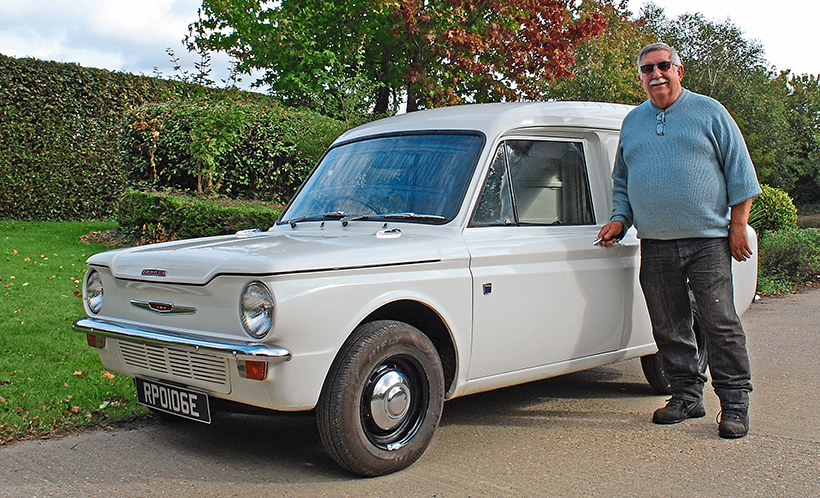
Trevor Woods and his 1967 Commer Imp van, which was registered in May 1967, in West Sussex.
The Rootes Group’s answer to the Mini, codename ‘Apex’, the Hillman Imp, was launched in 1963. The Coventry-based manufacturer needed a new factory to assemble the new car. The logical place to have built this might have been in Coventry, and Rootes did in fact own land next to their existing plant at Ryton-on-Dunsmore. However, the government wished to encourage manufacturing in deprived areas or where older forms of manufacturing were dying out. Central Scotland had traditionally had a big shipbuilding industry, but the rise in air travel meant that shipbuilding was in decline, as were the number of jobs in the region.
Therefore, due to a combination of sticks (no planning consent for the new factory in Coventry) and carrots (lots of lovely grants to build the factory where the government wanted it) Rootes’ new assembly plant ended up being built in Scotland on land outside the village of Linwood, near Paisley, close to motorways, railways, the River Clyde and to Glasgow airport. The village was expanded with new homes to accommodate the readily available workforce, some former dockers and some very experienced in building ships. Although not in building cars. The Duke of Edinburgh officially opened the factory in May 1963, then drove himself to Glasgow airport in a brand-new Hillman Imp.
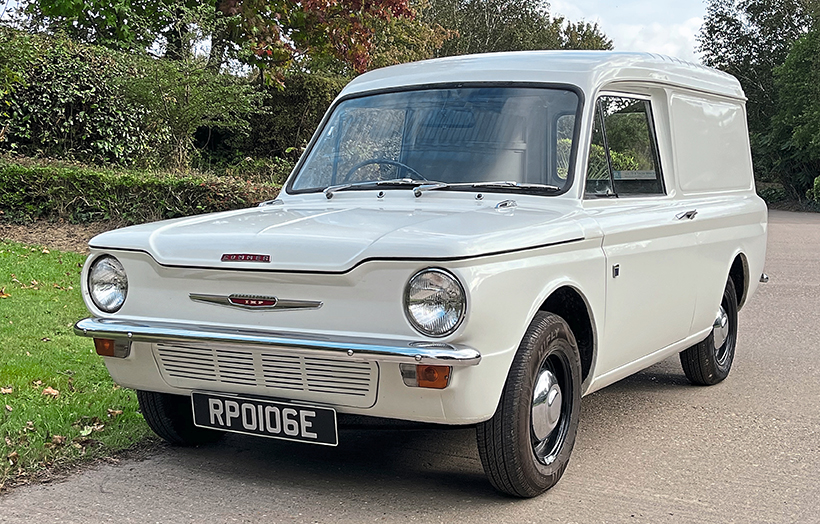
Front end is, as you’d expect, much the same as the Imp car, and because of the rear-engined layout, this could be the only light van ever to have a separate ‘boot’ space.
Initially, steel came from Gartcosh steelworks, then from the new Ravenscraig Steelworks nearby. Engines were cast in the Linwood factory, but, wait for it… were then sent by train down to the Rootes Group plant in Coventry to be assembled, before being returned to Linwood to install in the cars. Complete cars, too, had to be taken to the Midlands for distribution. So a lot of moving about, and all on small cars, and small cars generally equal small profit margins to start with!
The aluminium engine was a four-cylinder 875cc overhead cam unit derived from a Coventry Climax engine, mounted at 45 degrees in the rear. In standard form it produced 39hp, but gave reasonable performance being lightweight aluminium in the small Imp body. A four-speed all-synchromesh gearbox was fitted with a floor gearchange. There was all independent suspension with coil springs and swing axles at the front, whilst the rear had coil springs and semi-trailing arms. Rack and pinion steering and drum brakes all round were fitted.
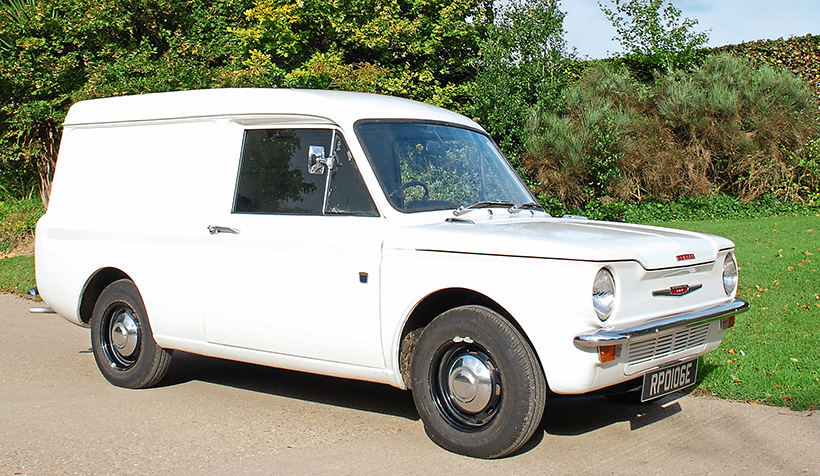
The van has been resprayed, but most of the metalwork underneath is original.
The 5cwt van version was launched as the Commer Imp in 1965. This had a higher roofline than the cars, extending to an almost vertical back end with a top hinged rear hatch, providing a load capacity of 70cu.ft. To stop the user getting burnt legs whilst loading and unloading, or fumes blowing in the back, the exhaust pipe exited at the offside rear.
The engine was below the floor, meaning that the flat load bay was higher than on front-engined vans, although that did make for easy loading. An optional extra rear seat could be specified which folded flat with the load bed when not being used, allowing flexibility to carry up to four people. If that wasn’t fitted there was extra storage space below the front of the load bed.
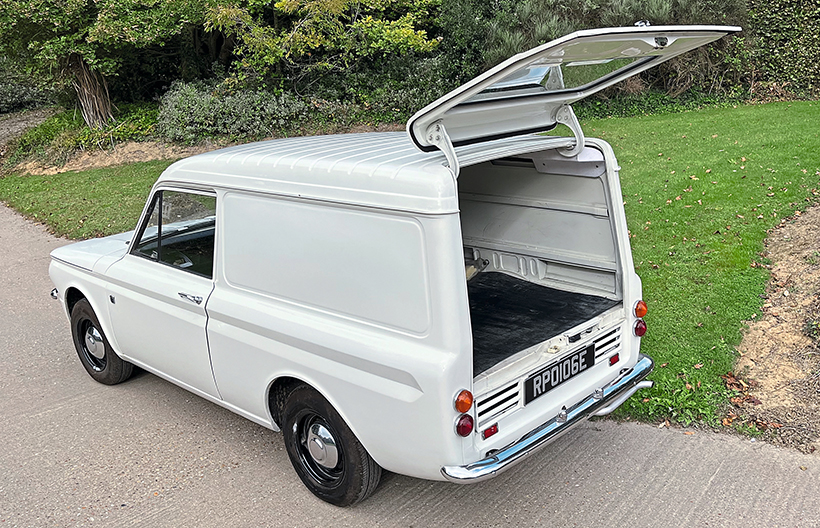
The square rear end and higher roofline allow for decent loadspace and was apparently designed to take the height of a milk churn. The top hinged tailgate aids access and provides shelter from the rain when loading.
Stronger rear springs, sturdier wheels and thicker drive shafts were fitted to the vans to cope with the loads, and the compression was lowered. Inside, rubber mats were the order of the day.
From 1968, the vans were badged as Hillman instead of Commer, and the Imp Mk3 dashboard was fitted. The van also leant its body to the Hillman Husky estate, introduced in 1967.
Both the van and the Husky were discontinued in 1970, shortly after Chrysler finally acquired control of Rootes, whilst the Imp cars lasted until 1976.
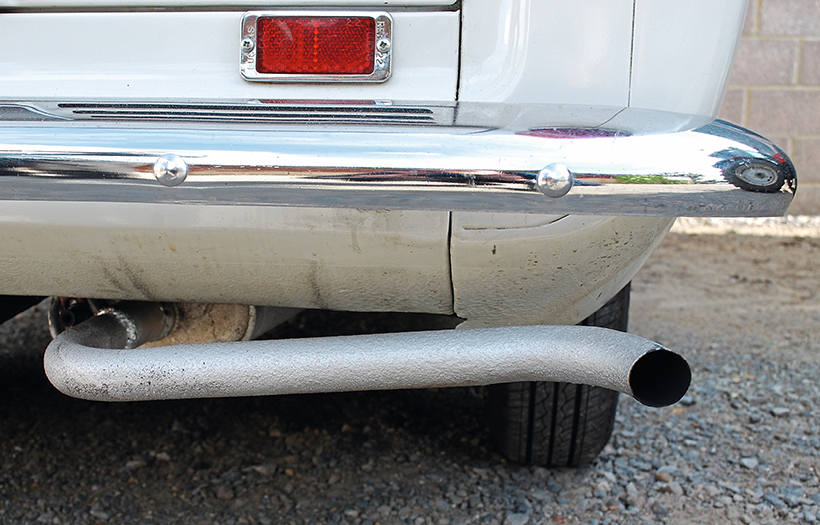
Exhaust pipe is extended to the rear offside to avoid problems if loading/unloading with the engine running.
Users of the Imp van included Glasgow Police, in pale blue and white Panda colours, along with Dan Air and the AA. They were also popular with TV rental companies, possibly due to their high load space, with Radio Rentals and DER among the users.
Low mileage survivor
This Commer Imp van was registered in May 1967 in West Sussex, and has been owned since 2003 by Trevor Woods from Chichester. The first owner was a kitchen fitter who laid it up in a lock-up when he retired, intending one day to do it up as a runabout, but never got round to it and it sat in a lockup in Worthing for 20 years, so it has not travelled far since it was supplied new by Harringtons of Worthing – a name that many will recognise as builders of some extremely good coach bodies and, with a further Rootes connection, fastback conversions Alpine sports cars. The van had done 47,000 miles from new.

From the rear. Tailgate is non-original.
The lock-up was one of about six in the grounds of a large house. The house owner had died, so all had to be vacated. The Imp’s owner had nowhere else to store it, so he called Imp spares and restoration specialist Malcolm Anderson, based in Devon. He in turn phoned Trevor, who lived nearer to the van, and asked if he would go and inspect it. Trevor went over that evening and sent some photos to Malcolm, who didn’t really want it but was keen that it should be saved.
“I said to Malcolm, ‘I’ve been looking for a van,’ so we agreed that I should buy it. The owner was in tears when I took it away, but he had to get rid of it,” recalls Trevor. “It wasn’t in bad condition. There were a few scabs where water had dripped through the garage.”
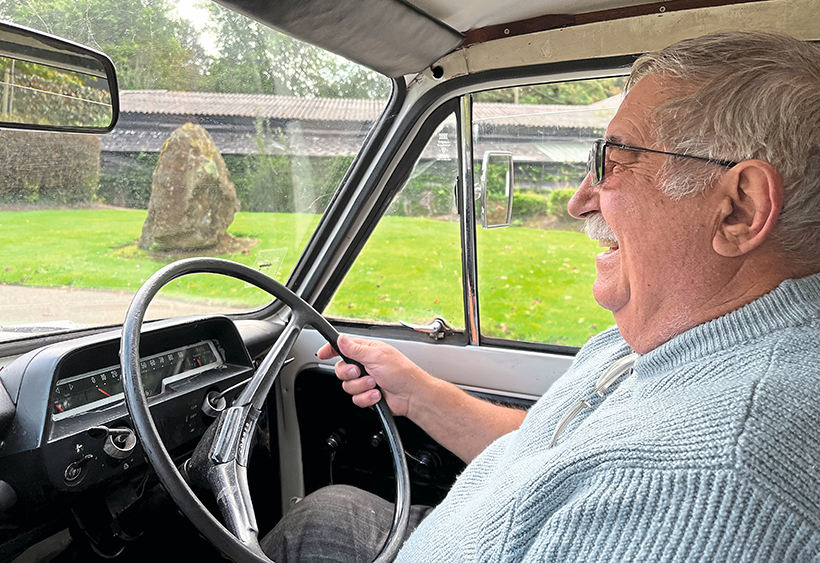
Owner and restorer Trevor Woods at the wheel.
Trevor first took the engine out, then stripped the body back to bare metal. A small hole in the floor had to be welded, but it was otherwise solid. Even the guttering was fine and just needed tidying up. It’s not the original tailgate, although he does still have that with the kitchen fitter’s signwriting on it, as that had got damaged when the van was used for the kitchen business.
Then Trevor moved workshops, other work got in the way and the project stalled. “Slowly but surely it went back together,” notes Trevor. However, friends and fellow car restorers Chris and Kevin got so fed up with seeing the van in primer that they painted it for him! They resprayed the van in its original colour, Polar White, using two-pack paint. Regular readers may remember seeing Chris Jones’ restoration of his Austin 1800 Ute in CVC in March 2023.

More comfortable seats from a Mk2 Imp saloon have been fitted.
Trevor spent ages trying to get the original engine to run. “I found that one of the liners had two chunks of metal missing. It was beyond being rebored,” Trevor explains. Fortunately, he already had an 875cc engine from an Imp saloon which he stripped down and rebuilt with new rings and bearings. “Van engines had dished pistons instead of flat tops, the lower compression allowing them to be run on 2-Star.”
Both bumpers were replaced, as the originals were very rusty. “I used an Imp Sport rear bumper which has two number plate lights,” notes Trevor. All Imp back bumpers had a hole for a starting handle, even though later Imps didn’t need one, as they had a big bolt holding the crank pulley on. “The rear Commer badge isn’t technically in the right position – they are normally fitted lower down on the rear crossmember. I moved it up where you can see it better, where I like it, although I sometimes get picked up for it by other club members!” Imp club badges have been fitted to the doors, but these are just glued on so could be removed.
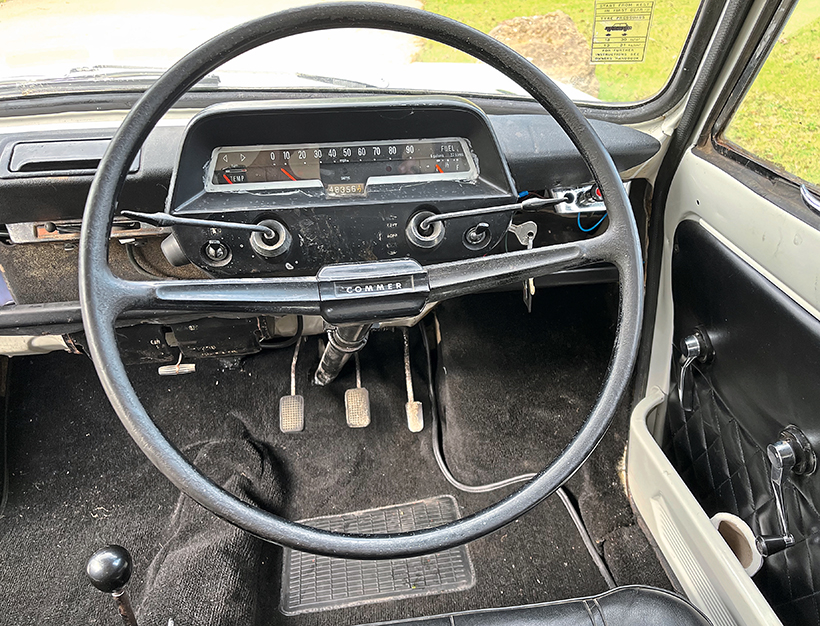
Steering wheel and dashboard are Mk1 Imp items.
Inside, Trevor added carpets and fitted a roof lining from a Husky – not as straightforward as it sounds. “The rubber round the windows would have held it in place on the Husky, but those aren’t there on the van.” Wood strips were used to hold it in place instead. The door cards were originally just that – cardboard. Trevor had new ones made up in MDF, covered in vinyl with diamond stitching, and then added door pockets off a saloon, which the van didn’t originally have – you pulled the door closed with the handle at the top of the door, lacking on the saloon.
The van has the same dashboard as the Mk1 saloon. “I’ve put more comfortable Mk2 Imp seats in – the Mk1 seats fitted were very thin and in a bad state,” Trevor tells me.
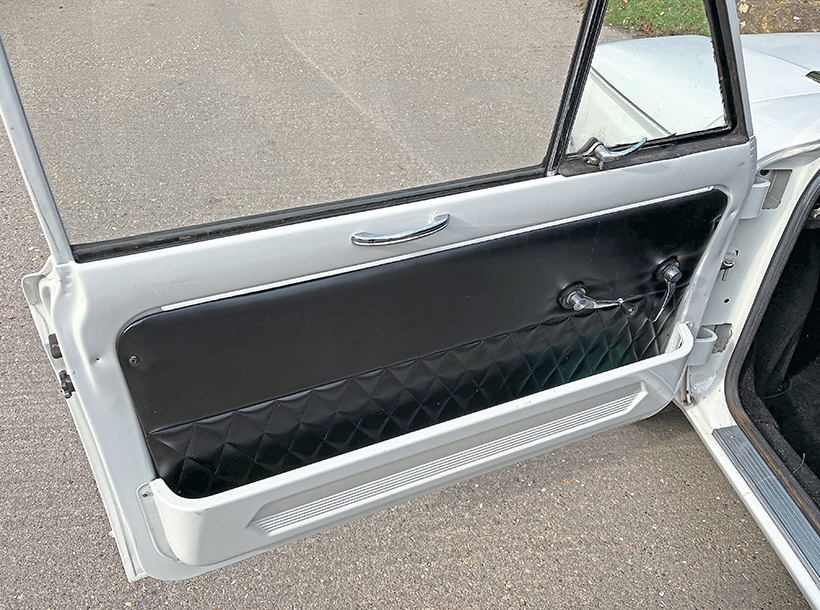
Note the door pull handle fitted to vans; door pockets are off a saloon.
Trevor got into Imps through his son, who had a 1967 Hillman Super Minx 1725cc auto as his first car. Knowing he had a Hillman, a friend’s dad told him he had an old Imp that he wanted to get rid of. Trevor took it on and got it running. After that he started buying others, joining The Imp Club in 1996, doing several club meets, and is now one of the longest serving club members in the area. His workshop contains extensive racking, 99% of which is Imp stuff. Now retired, he mainly works on other club members’ cars, or helps out Chris and Kevin in the next workshop.
“They are easy to drive, fun little cars,” enthuses Trevor. “It goes well, cruising at about 60mph, although I’ve got one rattly tappet to sort out. The flat floor is at a convenient height, but there’s nothing to stop the load crashing forward into the back of the driver if you brake hard!”
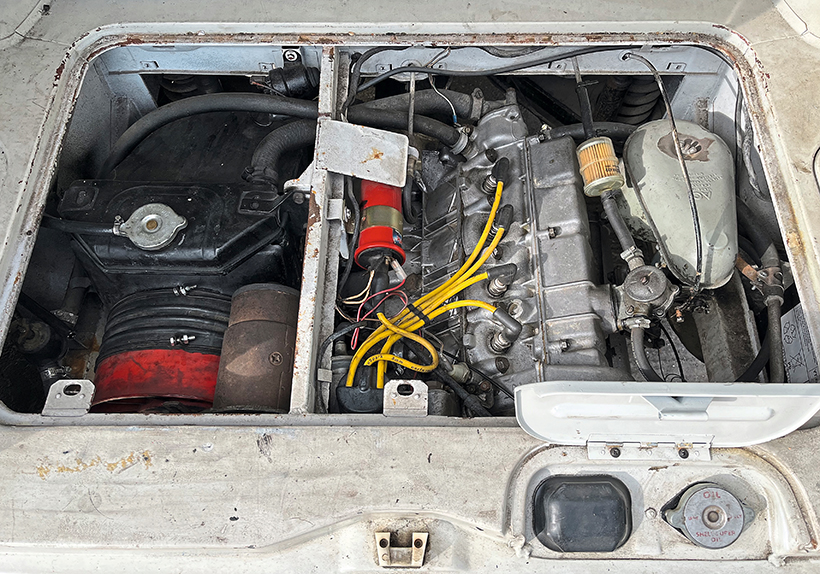
Engine sits under the loadspace, which is a tad awkward if a problem arises while the van is loaded.
I asked Trevor about the practical side of running Imps. “The Imp Club is pretty lively and good for spares. People like Malcolm Anderson put their money where their mouth is and get stuff remanufactured. Express Steel make wings, sills, quarter panels, door skins and so on – not cheap but there if you need them. You can get a whole or half floorpan. Also, Speedy Spares until their demise. Some parts are shared with other vehicles. Front wheel cylinders were also used on HA Vivas. Rear brakes were fitted to some early Escort vans. The front indicators/sidelights are the same as the Hillman Hunter.”
“Some of the younger Imp Club members have fitted BMW motorbike engines with an adaptor plate that bolts straight onto the gearbox. Suddenly they’ve gone from 875cc to 1,200cc fuel injected!”
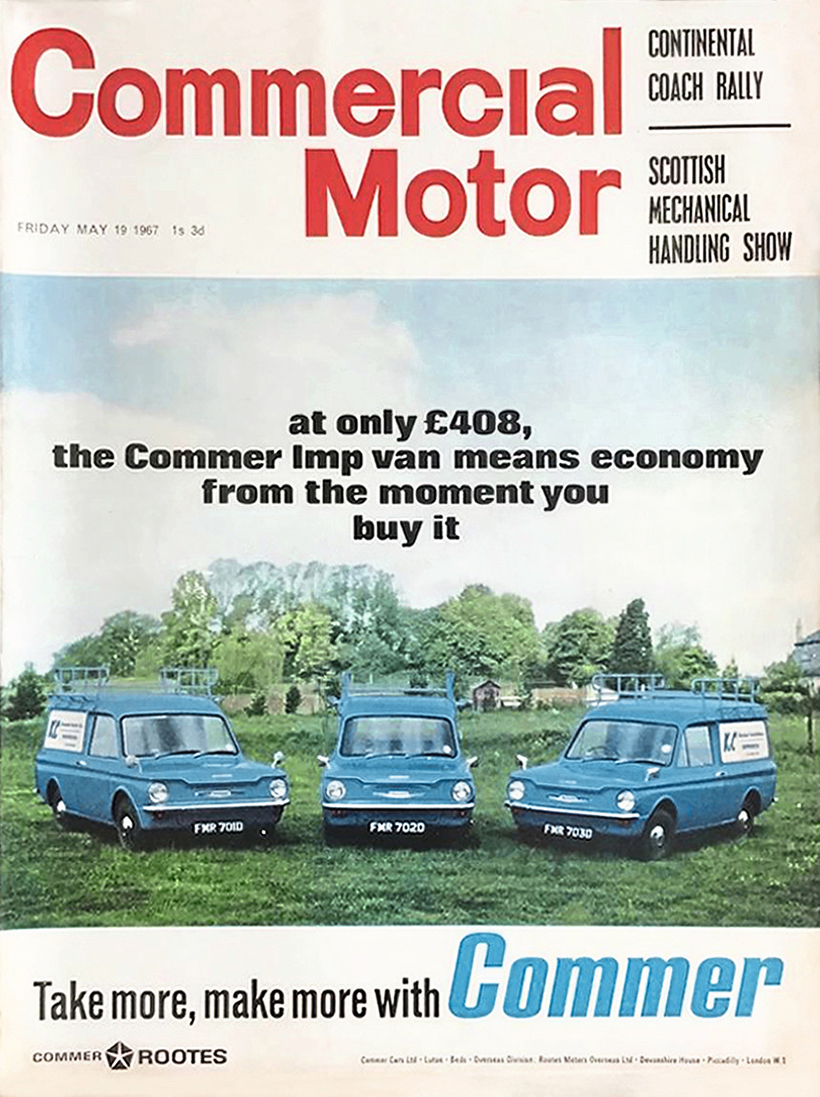
A Commer Imp van cost £408 new in 1967 – back then, cars had Purchase Tax on their prices but vans did not.
To finish the van off, Trevor ordered a new set of number plates. However, when they turned up, the supplier hadn’t put a space in between the letters and numbers, so replacements will need to be made.
Few Imp vans remain. Some were converted to look like Huskies with side windows added. “Fewer than 10 vans turn up to the big National Rallies,” notes Trevor. “I took this one to the 60th birthday bash in Coventry.” It’s good to see this one back on the road.
This feature comes from the latest issue of Classic & Vintage Commercials, and you can get a money-saving subscription to this magazine simply by clicking HERE

Previous Post
The brilliant Drive-it Day at Bodle Street Green
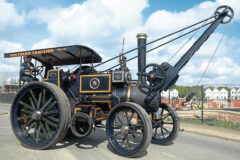
Next Post
Special engine to attend High Weald Steam Rally



